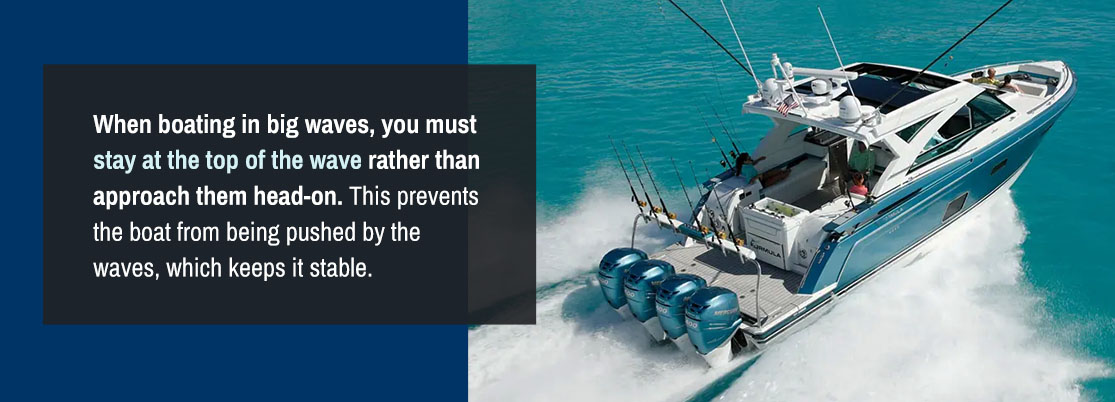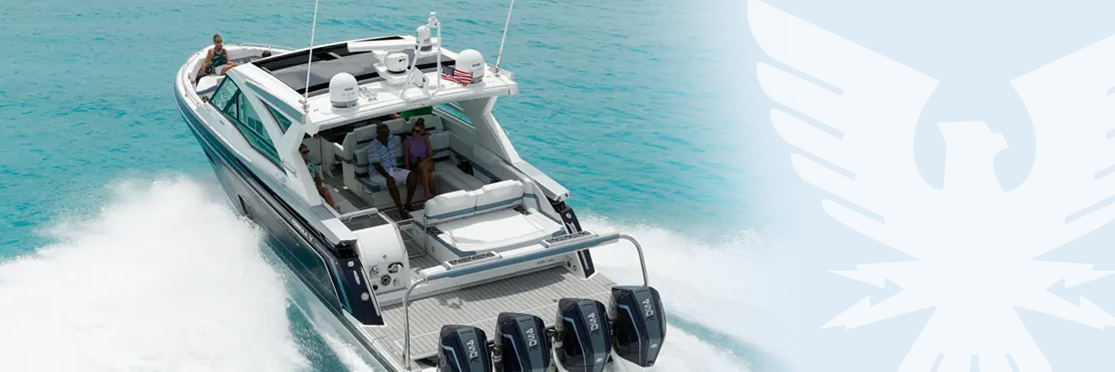
Waves play a significant role in how you will operate your boat. Improperly operating your vessel during certain waves can lead to capsizing. When you know about wave formation and the types of waves you could encounter on the water, you will be better prepared to navigate safely out of dangerous situations.
Table of Contents
- The Importance of Understanding Waves While Boating
- How Waves Work and Their Effect on Boating
- How Do Ocean Waves Form?
- Types of Ocean Waves and Tides
- What Causes Waves to Break?
- How to Boat In Waves
The Importance of Understanding Waves While Boating
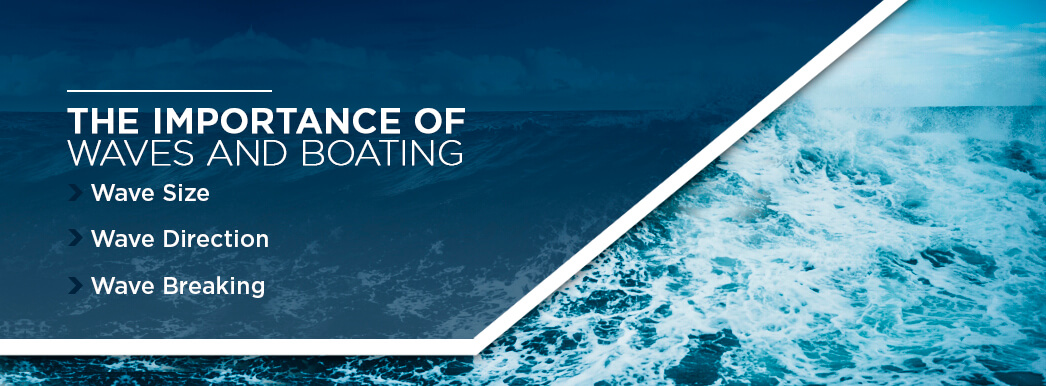
Knowing the types of sea waves you will face and how to deal with them is critical for handling a boat on any body of water. Waves can be dangerous obstacles that can swamp an open boat with water or roll a vessel to its side. Even if you have a large boat, steering improperly through large waves can lead to disaster.
Knowing about waves is only one part of navigating your boat through them. While nothing matches experience, there will always be a first time to encounter dangerous waves for all boaters. Understanding the factors that make waves dangerous, where they come from and how to handle them can help you to emerge safely from heavy conditions.
When boating, you need to consider the size and direction of the waves and whether they break. These factors significantly affect how the waves impact your vessel and how you will need to compensate your steering:
WAVE SIZE
The size of the waves you encounter will determine whether your boat can handle them. If you have a larger, more powerful boat, you can handle bigger waves compared to someone with a small craft.
WAVE DIRECTION
The direction the wave comes from and strikes your boat makes a difference in whether your boat rolls or not. For example, a wave that hits a boat at the bow or stern is far less likely to knock it over completely.
WAVE BREAKING
Breaking waves happen when waves reach such heights that they cannot stay upright, and they collapse. The collapsing wave brings with it the force of the water it carried. While such waves can happen when larger waves enter shallower water, winds blowing across a current can also cause them. In some cases, they can occur in deep water without apparent cause. You should avoid these dangerous waves if possible.
How Waves Work and Their Effect on Boating
Waves are caused by energy traveling through the water. Unobstructed, waves can traverse an entire ocean. They most often originate from wind moving over the surface, but the gravitational force of the moon also creates waves.
Various types of waves can appear while you are on the water, and recognizing how each type forms can make it easier to avoid the most dangerous types of conditions.
How Do Ocean Waves Form?
Energy passes through the ocean in a circular motion. When the wind blows over the surface, it disturbs the water, creating surface waves. Factors that influence surface wave creation are the wind speed, duration and the surface distance it covers, also known as fetch.
Surface waves are only one type of wave. Others, like tsunamis, occur from underwater earthquakes or landslides into the ocean. The agitation creates energy that moves through the water. With a variety of waves, including boat wake and tidal waves, individual formations vary widely.
Though a wave will move your boat up and down, the water actually moves in a circular pattern with just enough movement to keep the energy going forward. The energy of surface waves also affects the water beneath, but the circular motion of the energy flattens as the water deepens until the waves’ energy dissipates.
When talking about waves, you may hear some of the following terms:
- – Period: The period of a wave refers to how quickly it travels from one point to another.
- – Frequency: Wave frequency is how quickly the waves move past a single point.
- – Trough: The trough refers to the lowest portion of a wave.
- – Crest: The crest is the highest part of the wave.
- – Wave Height: Wave height measures the distance between the trough and the crest.
- – Wavelength: Wavelength indicates how far it is between crests.
Types of Ocean Waves and Tides
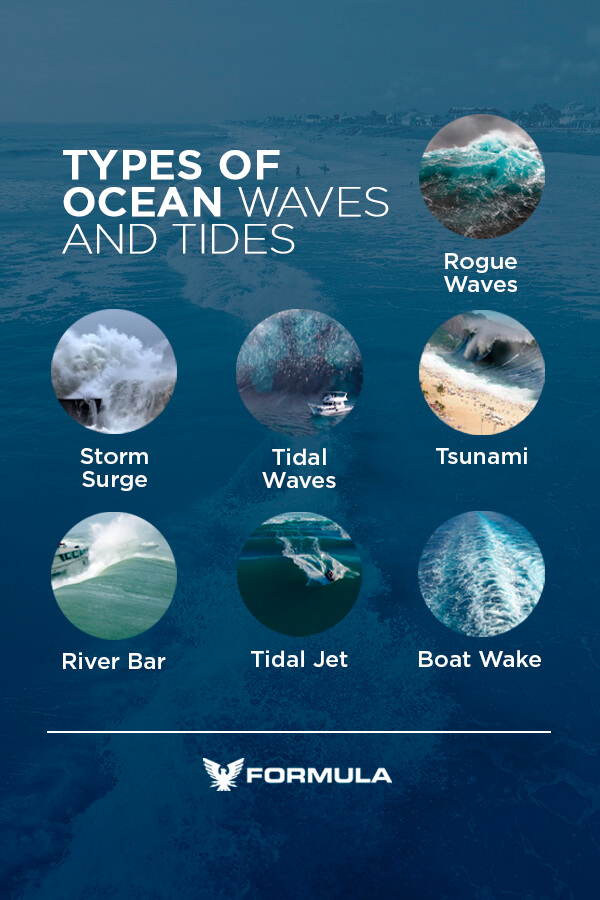
Waves are not all the same. Some have smaller heights and present less danger to boaters than others. Before you go out on the water, you need to know the types of waves you may face and how they form.
Understanding these formations and what causes them can help you to predict when you may need to change course. Some common types of waves include:
1. ROGUE WAVES
The most dangerous type of wave is also the most mysterious. Known as rogue, killer or freak waves, their many names indicate their unknown origins. Scientists know them as “extreme storm waves.” What makes them so dangerous is their size relative to the surrounding water. Rogue waves can appear twice as tall as the seas they spring from.
While scientists still debate the precise cause of these formations, certain factors play a role in rogue waves, like:
- Combining swells: When swells interact with each other, they can combine their forces. If the swells move in the same direction, the combination results in large rogue waves that last for several minutes.
- Currents against the waves: Storm waves that form in a different direction from the natural wave pattern shrinks the frequency between waves until the waves join together. These types of waves tend to last longer than those from combined swells.
2. STORM SURGE
Storm surges precede hurricanes and other serious storms. This occurs when storms push excessive water onto the shore, causing localized flooding. Water rises high above the typical sea level, and it can reach even higher when the storm surge coincides with high tides.
Storms will also cause long, deep water waves that increase in size as they near the shore. Even a storm hundreds of miles away can cause intense waves along the coast from the energy that traverses through the water from the hurricane. You must be aware of both local and regional weather to predict the presence of storm surge waves.
3. TIDAL WAVES
While some people equate tidal waves and tsunamis, the two are completely different phenomena. Tidal waves occur from the gravitational pull of the moon and sun on the Earth’s oceans. They are also known as tides.
Technically, tides are the largest waves that occur because they cause visible differences in the sea levels along the coastlines. Luckily, unlike other waves, tides are predictable. You can find times for high and low tides in your local weather reports.
While high and low tides occur daily, spring and neap tides happen only occasionally. Spring tides happen when the sun and moon are aligned, pulling more on the water, creating higher tides. Neap tides happen when the two celestial bodies are on opposite sides of the planet, resulting in lower tides.
4. TSUNAMI
Tsunamis are rare waves that occur when a landslide or earthquake moves a large amount of water. The disturbance often causes multiple waves that travel long distances at speeds up to 400 miles per hour. Though unpredictable, scientists can send out warnings if conditions create the likelihood of a tsunami reaching land. Like a storm surge, a tsunami raises the sea levels quickly at the coast and extends far inland.
In some instances, when the coastal waters become shallow, the energy from the tsunami creates taller waves in the shallower waters. In some cases, wave heights can reach up to 66 feet. Whether a tsunami will create tall breaking waves, a fast sea level increase or both depends on the conditions surrounding the land and the amount of energy the tsunami has.
5. RIVER BAR
River bars occur where rivers flow into open water. The forward motion of the river outlet colliding with the water in the larger body can create subsurface turbulence that builds up sandbars. When water approaches these sandbars, it can build up into waves.
To avoid problems when crossing a river bar, don’t do it without research. Only cross a bar when the tides are incoming or standing. These conditions will help to regulate the periods of the waves around the bars, making them more predictable. You want to reduce the number of unexpected encounters you have with waves as much as possible to keep your boat upright and safe.
6. TIDAL JET
Waves can build near narrow inlet openings during times of tide movements. The biggest waves can happen when large incoming waves meet an ebbing tide. Be wary of these types of waves and use the tidal conditions to determine the best times to go out on your boat. Know where obstacles underwater lie to be aware of where the waves most likely will develop.
7. BOAT WAKE
Boat wake waves can affect your vessel, especially if you regularly frequent heavily trafficked waters. If possible, don’t allow the wake to hit your boat on the side. Approach it from the bow to prevent taking on too much water or rolling your boat. Plan an escape route if you have multiple sources of boat wake coming at you from different directions.
What Causes Waves to Break?
Waves will break when they get too steep to maintain their height. Since waves generally build in height in shallower waters, you can determine the depth where breakers will most likely form. The equation for this depth is the sum of the wind-wave height and the forecasted swell. Multiply this value by 2.5 to find the minimum depth for water that should not have breakers.
How to Boat in Waves
Dealing with waves depends on the type of boat you have and the waves you will encounter. For instance, you deal with large waves differently than smaller ones. Here are some tips for navigating waves in a variety of situations:
How to Hit Waves in a Boat
When boating in big waves, you must stay at the top of the wave rather than approach them head-on. This prevents the boat from being pushed by the waves, which keeps it stable. The best way to stay at the top of a wave is by reducing your speed. Then, focus on maintaining your boat at a 45-degree angle facing the waves. At this angle, you will hit the waves head-on.
Do not make any sudden maneuvers in rough water conditions. Doing so will greatly increase the risk of capsizing. To change your direction, you must move slowly and steadily. You must also keep your boat’s bow as high as you can. This can be done by trimming your outboard motor.
How to Navigate Large Waves in a Boat
When it comes to waves and boating, the more you know, the better. These are some helpful tips to know when boating in rough conditions:
- Check the forecast: Before setting out, be sure to check the marine weather and wind forcast for your area. If possible, avoid going out on the water when rough or stormy conditions are expected and follow all local guidance.
- Slow down: The first thing to do in choppy waters is reduce speed. If you are unsure what speed to go, then adjust your speed to match the size and frequency of the waves.
- Compare boat size vs. wave height: You can determine dangerous wave heights based on the size of your boat. If the wave height matches the beam of your boat, it may be at risk of pitchpoling, knock-down or rolling.
- Secure objects: Tie down your belongings when boating in choppy waters and big waves. Chairs, fishing gear, coolers and everything that isn’t nailed down must be secured or put in closed compartments.
- Remain calm: Staying calm in these situations is essential. You must keep your wits about you and stay focused on getting through the rough waters.
How to Steer a Boat in Big Waves
While navigating and steering through big waves, there are two things you need to identify. The first is the type of waves and the second is their direction. Your main goal is to position the hull properly in relation to the direction of the waves. The angle you are cruising at should make your journey as comfortable as possible.
When rough waves are heading in the same direction you are, that doesn’t necessarily mean smooth sailing. There are still risks to be aware of. When going against the waves, your hull crashes into them and the bow tends to rise up. When following the current and waves, the stern rises. This forces the bow down, making it ram into the next wave and resulting in an uncomfortable journey.
To avoid this issue, you must keep the bow as high as you can, maintain high angles of trim, and balance the bow. This stops it from colliding with the next wave. When the waves are short, it’s easy to maintain a steady course.
About Formula Boats
Since 1976, Formula Boats has been a family-owned and managed staple of Decatur, Indiana. From the start, the company leaned on the knowledge and boat construction expertise of Vic Porter. He had previously served as president of Duo, Incorporated and Signa Corporation, both well-known boat makers of the time.
Despite our local roots, our boats are renowned all over the world for their innovation and customization options. Our 60 years of experience has allowed us to develop the latest in technology, such as our FAS3Tech® hull. We also give you the power to choose features and configurations for your boat. If you want to conquer the waves, navigate through them using one of our performance boats, cruisers or yachts.
Find out More About Our Selection and Contact Us Today
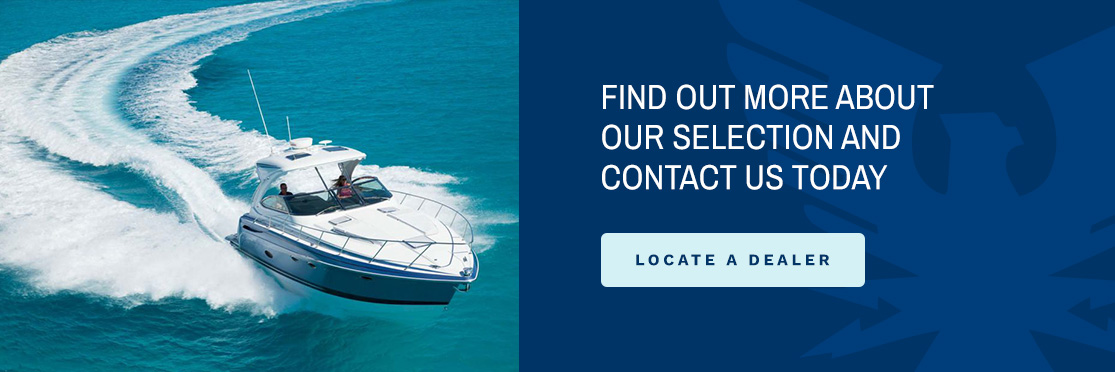
If you want a fully customizable boat that has the power, luxury or both that you crave, trust us at Formula Boats. You can get the power you need for handling a variety of water conditions or waves. We also have luxury options that can take on smaller waves better due to their larger size. Check out our selection online, build your own boat or let us know how we can help you to get the vessel of your dreams.
For more information, or to get answers about our products, contact us online.

